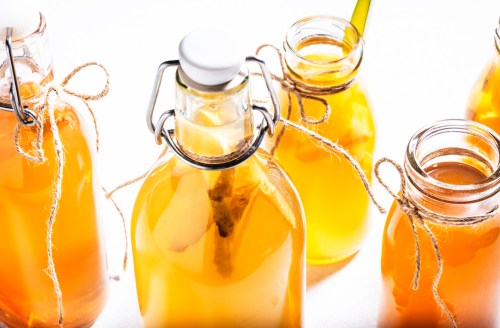Kombucha has risen to wellness fame in recent years, but there’s a whole world of fermented drinks out there to explore past the buch. One that’s started getting more attention thanks to its refreshing, pineapple flavor is tepache, a fermented Mexican drink.
Mexico is home to over 200 different types of traditional fermented foods and drinks, and tepache is one of the most famous. Made from lightly fermented pineapple rind and core, tepache is packed full of probiotics, and is also a source of prebiotics and antioxidants.
Historically, the nutritional content of tepache has largely been unknown, but in recent years researchers have begun studying it in more detail. Dr. Beatriz Pérez-Armendáriz and Dr. Gabriel Abraham Cardoso-Ugarte are two of the scientists getting to know the drink and its range of health benefits.
“It is hard to determine the history or the origins of the tepache, but it is known that it has been consumed since pre-hispanic times,” says Dr. Cardoso-Ugarte. “The exact recipe for tepache has changed over time with different fruits, spices, and fermentation methods used to enhance the flavor.” Orange, tamarind, guava, and apple are featured in some recipes, says Dr. Cardoso-Ugarte.
As the drink is not made using standardized methods, “the microbial profile of tepache varies substantially depending on the producer,” explains Dr. Cardoso-Ugarte. However, it tends to contain mostly lactic acid bacteria, which are one of the most significant groups of probiotic organisms.
Tepache is simple to make at home and helps to reduce food waste by using up leftover pineapple rind that you’d otherwise throw away. “Traditionally, it is spontaneously fermented in wooden barrels called ‘tepacheras’,” says Dr. Cardoso-Ugarte, but if you’re making tepache at home, a large glass jar or bottle will do. You can also add anti-inflammatory spices like cinnamon and ginger. “In some cases, a pinch of clove or star anise, [or] even pepper are included,” adds Dr. Cardoso-Ugarte.
The pineapple used in the fermenting process comes with its own host of nutritional benefits too. As dietician Krista Linares, RDN, explains, pineapple, like many other tropical fruits is an excellent source of vitamin C, which is an important antioxidant and used for many other bodily functions such as collagen production. It’s also rich in other vitamins and minerals including manganese and B vitamins.
Linares has both Mexican and Cuban ancestry, and she’s passionate about embracing the Latinx culture whilst helping patients manage chronic health conditions and food allergies. “A lot of the stereotypes about [Latinx] food being unhealthy start to break down when you actually explore the food traditions in Latin America,” she says. Many people aren’t aware of the health benefits that drinks like tepache can provide. “Probiotics help deliver beneficial bacteria to our gut, and can help maintain regular healthy digestion,” says Linares.
When it comes to making traditional Mexican drinks, a good place to start is by making your own aguas frescas (BTW, there are plenty of tamarind benefits, a popular agua fresca flavor), or Latin American fruit juices, and gradually using less sugar, Linares recommends. “Tepache will still need some sugar for fermentation, but you can adjust how much sugar you add after the fermentation process,” she says. If you’re really conscious about your sugar intake, you can also use raw honey to make tepache.
Here are two recipes to make your own tepache at home: a traditional method and a low-sugar option.
How to make tepache from scratch
Traditional Tepache
(from Dr. Beatriz Pérez-Armendáriz and Dr. Gabriel Abraham Cardoso-Ugarte)
Ingredients
1 ripe pineapple
100 grams piloncillo (similar to molasses)
200 grams brown sugar
2 cinnamon sticks
3 pieces of star anise
1. Wash the pineapple thoroughly with water.
2. Peel the pineapple, keeping the skin and 100 grams of the fruit.
3. Grate or chop the piloncillo and place it in a pan. Add the spices, brown sugar, and 3 litres of filtered water. Heat until you have a thin syrup.
4. Place the pineapple skin, core and pulp in a wide bottle, add the syrup and spices, and add more water to fill the bottle.
5. Cover the bottle with a balloon and store at room temperature.
6. Let the mixture ferment for 1 to 5 days. Sometimes fermentation will be faster, so check and taste the product daily. When you’re happy with the final taste, strain and refrigerate.
Tepache made with honey
(My own adapted from this Hello Glow recipe)
Ingredients
1 ripe pineapple
2 cinnamon sticks
3 cloves
2 cardamom pods
Thumb-sized piece of fresh ginger
2-3 tbsp raw honey
1. Wash the pineapple thoroughly with water.
2. Peel the pineapple, keeping the skin and core.
3. Peel and thinly slice the ginger.
4. Add the pineapple skin and core, spices and honey to a large glass jar. Fill the jar with filtered water.
5. Stir the mixture to dissolve the honey. Cover with a cloth or coffee filter secured with elastic.
6. Let the mixture ferment for 2 to 3 days. Taste and leave to ferment for longer if needed. When you’re happy with the final taste, strain and refrigerate.
Sign Up for Our Daily Newsletter
Get all the latest in wellness, trends, food, fitness, beauty, and more delivered right to your inbox.
Got it, you've been added to our email list.











